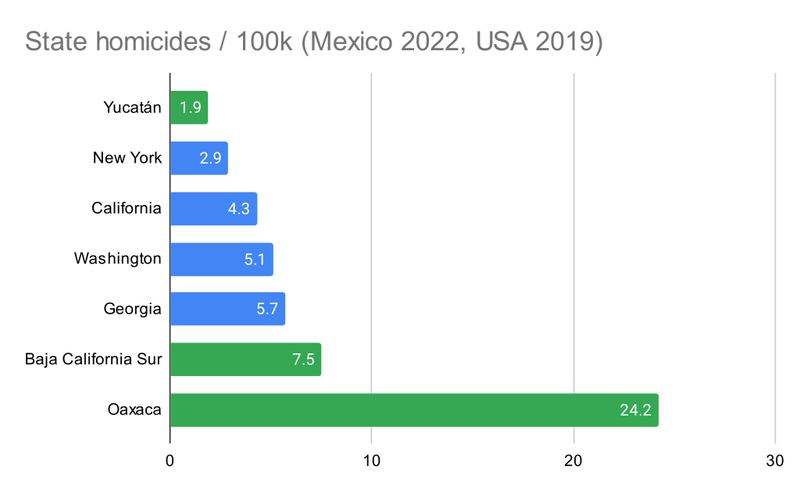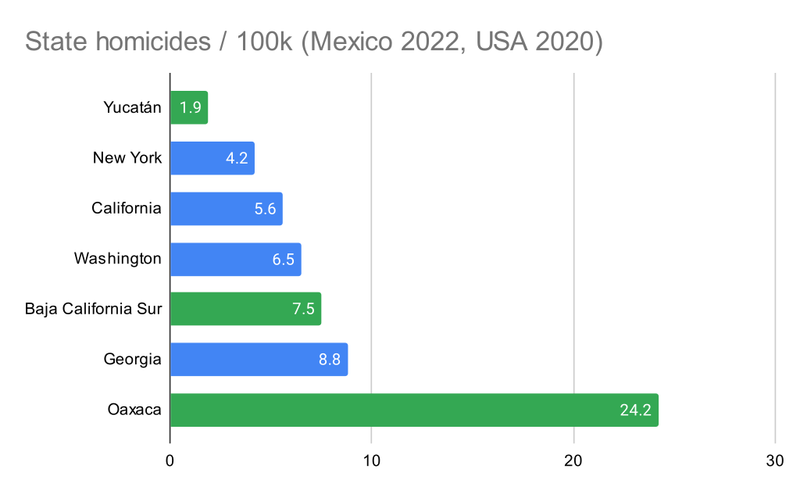Visiting Mexico can be safe and sublime
Mexico is an amazing place to visit, but a lot of people I know have never been, or haven’t been in a long time, despite enjoying international travel. In this post I’ll explain why I think you should consider visiting and address some common reasons people don’t go, including safety. This is not a travel guide, but I’ll provide a few recommendations for where to go and a few tips for how to do it.
If you’re the type of person who goes for celebrity endorsements:
Each time in Mexico, no matter how short the visit, shows it was worth the trip in the first two hours of being there.
— tylercowen (@tylercowen) November 18, 2016
The good stuff
For people coming from the USA
It’s close! There are lots of flights, and they’re not too long. E.g., flying from San Francisco to Mexico City takes 4.5 hours. And the time zones are similar, meaning less jet lag, and it’s easy to work remotely.
For everyone
Relatively affordable
The Trivago Hotel Price Index says the average hotel room in Mexico City in 2023-03 is $110 ($249 in San Francisco, $258 in Paris). A seven-course tasting menu with drinks at the amazing Criollo in Oaxaca costs less than $50.
Loads of history
Many parts of Mexico feel storied in the same way places in Europe or Asia do, but that’s relatively rare in other parts of the Americas. You can climb on the ruins of cities that were at their peak hundreds of years before the Spanish conquest, and engage with a culture that is descended from the ones that built those cities.
Great food
I’ve had several friends move from California to Europe and cite Mexican food as the main thing they miss. And the Mexican food in California is not nearly as good as the food in Mexico! You can eat extremely well on the street, in a market stall, or in fancy restaurants associated with internationally renowned chefs. If you want to cook for yourself, there is fresh and cheap produce available at open-air markets, supermarkets, or even Wal-Mart.
Warm weather
I love going to Mexico during the winter. It’s a big country with a varied climate, but hardly any place is actually cold during the winter. The average high temp in Mexico City is 22°C / 71°F in January and 25°C / 77°F in June. Many coastal areas are warm enough that swimming is extremely pleasant year-round.
Friendly people
Mexicans are very open and welcoming to foreigners. A survey of expats by InterNations found Mexico “comes first in the Local Friendliness, Finding Friends, and Culture & Welcome Subcategories. Expats describe the local residents as friendly (90% vs. 66% globally) and find it easy to make friends among them (75% vs. 42% globally).”
The bad stuff (is not too bad)
There are some aspects of Mexico that are not ideal, but there are ways to mitigate those issues. For me, the major ones are:
- Safety
- Air Pollution
- Weather
- Language
Safety: avoid the violent places and wear a seat-belt
Violent crime is very bad in some parts of Mexico, but it’s easy to avoid those parts. Road accidents get less press but I think are actually a larger danger for most tourists. Here are some tips for staying safe from both.
Road accidents
My nearest brush with death in Mexico came as I was driving on a freeway at night when a herd of cattle emerged from the desert onto the road in front of me without warning. Luckily I was driving slowly enough to stop with plenty of time.
You can do the following to reduce your risk:
- If you have a choice between a free (“libre”) and a toll (“cuota”) road, pay the toll. The road will be much better maintained and your journey will take less time.
- Minimize time spent on the road at night, especially in poorly lit (rural) areas.
- Minimize time spent in colectivos (vans that operate as public transit). They’re fun and cheap, but rarely do riders get to wear seat belts.
- Often the seat belt buckles will be stuffed underneath the seat cushions. Take the time to pull them out and fasten yourself in.
- Tell your driver (via a translation app if necessary) to slow down if they’re driving too fast.
The appendix has some data on road accidents.
Violent crime
Violent crime is much worse in Mexico than in many other places. However, it is very unevenly distributed, and there are locations that should be safe enough for all but the paranoid.
I suggest you look at the homicide rates for any place you’re considering visiting. I suggest looking at homicide rates because homicide likely has the most accurate official statistics of any crime (one reason is that deaths are frequently tabulated by different agencies (e.g., the coroner) than the ones responsible for crime statistics, so there are multiple independent data sources), and it probably correlates strongly with other violence.
Here’s a map from El Crimen, where brighter means more homicide:
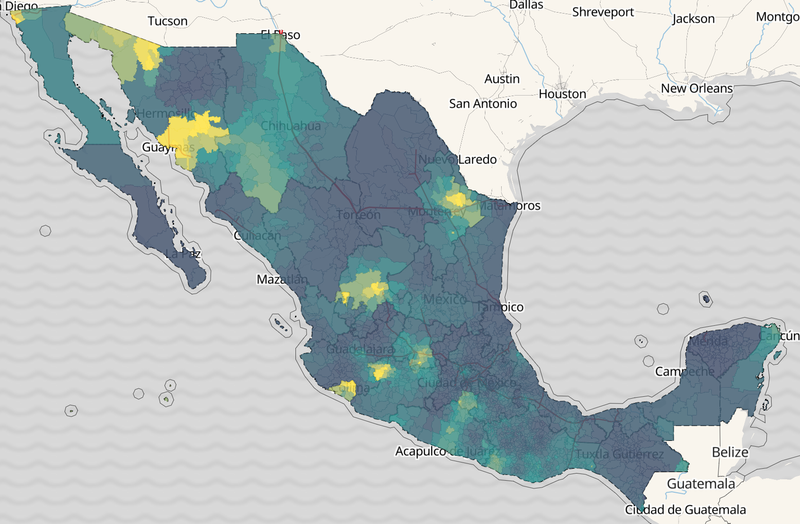
One of the brightest spots is Guaymas, Sonora, which has a homicide rate of 115 / 100k population. That’s way more murdery than I would be comfortable with, but just avoid the bright spots and you’ll probably be fine!
Here are some homicide rates in a few cities in Mexico that I recommend in green, compared with some cities in the USA and France you might be familiar with:
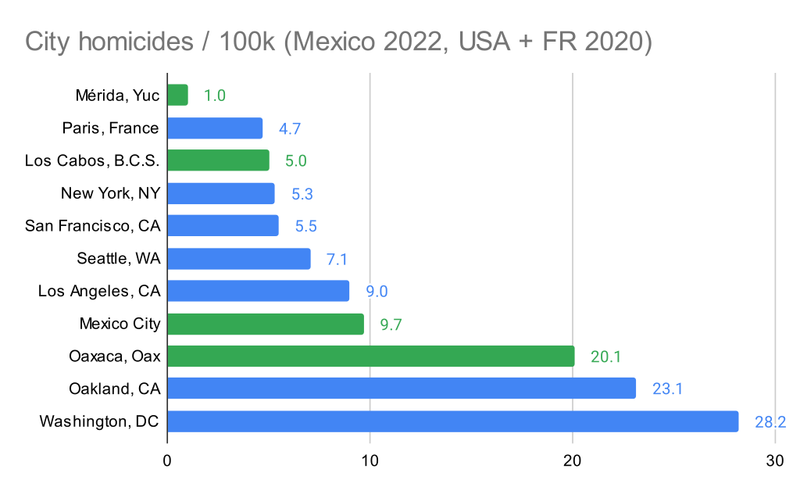
We can see the city with the highest homicide rate that I’ve recommended is Oaxaca, which has a rate significantly less than Washington DC. In both Washington DC and Oaxaca I think the places a tourist is likely to visit are very safe.
The appendix has details on the data sources and some more data.
Air Pollution
Air pollution in Mexico City is bad enough that it would deter me from living there long term. However, most places in Mexico have much cleaner air than Mexico City, and even there the air is clean enough that I’m entirely comfortable visiting.
You can use IQAir to check air quality before your trip. For any particular station, scroll down to the “historical” section to get a feel for the typical values. You can look at this page to see annual average data for different cities across the world. If I were going to Mexico City or another place with sometimes-bad-air, I would take an N95 mask just in case.
Language
I don’t have personal experience with this issue because I speak Spanish pretty well. My guess is that life as as an English speaker is a bit easier than in e.g., Thailand, but harder than in e.g., Switzerland. Everything is written in a Latin script, which makes it easy to read and type in to your phone. There are English-speaking guides available for hire outside many tourist attractions.
Google Translate works quite well between English and Spanish, and it can translate text from photos you take with your phone.
Where to go
These are not the only places worth going to. These are some of the places that I have visited myself. For each place I note a few highlights to get you excited and get you started on your trip planning.
Yucatán state (W)
Balance of culture and nature. Pre-columbian ruins (e.g., Chichén Itzá), beautiful cenotes (pools in limestone caves where you can swim), excellent birding (e.g., in Ría Lagartos), great food (e.g., marquesitas, sikil paak, panuchos), and the safe, walkable and charming capital city, Mérida.
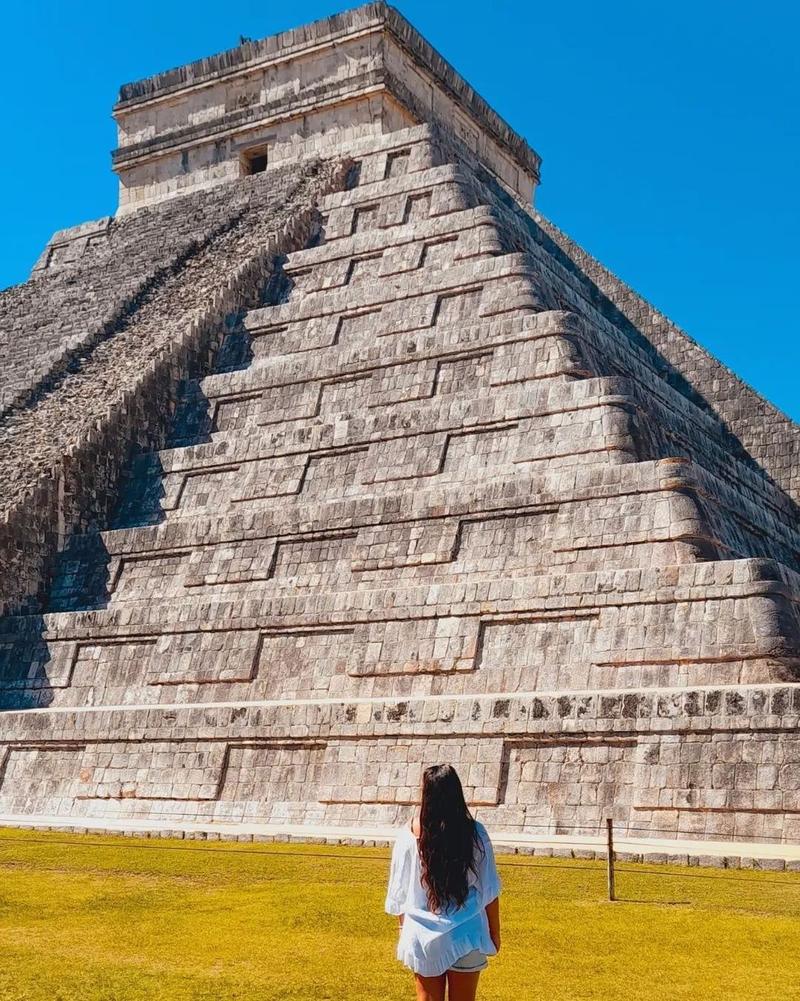
Baja California Sur (W)
Low on culture, high on nature. Release newly hatched sea turtles (e.g., in Todos Santos), get really close to mother and child whales (in the San Ignacio Lagoon), kayak and swim with seals and dolphins (e.g., near Loreto), hike in the desert to find prehistoric petroglyphs, snorkel, SCUBA dive, or surf. If you want to stay at a fancy resort, there are lots of those in Los Cabos.
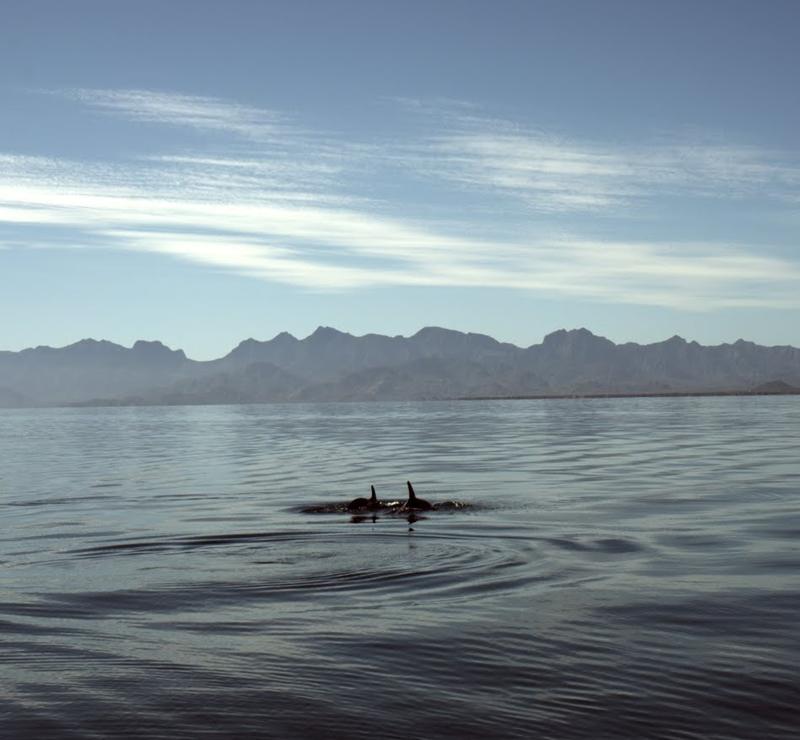
Mexico City (W)
High on culture, low on nature. Pre-columbian ruins (both in the middle of the city e.g., Templo Mayor and just outside in Teotihuacán), amazing architecture (e.g., the Postal Palace, University City), great museums (e.g., National Museum of Anthropology, Palacio de Cultura Banamex), religious pilgrimage sites (e.g., Basilica of Our Lady of Guadalupe), fancy restaurants (e.g., Contramar), food from every region of Mexico, and excellent Lebanese food (e.g., Al Andalus).

Oaxaca state (W)
High on culture, medium on nature. The best food in Mexico (e.g., mole), pre-columbian ruins (e.g., Mitla), a vibrant economy of artisan goods such as ceramics (e.g., the people in San Bartolo Coyotepec who have been making pottery for 2000 years), relaxing beach towns (e.g., Puerto Escondido), excellent bird-watching (e.g., at the Laguna de Manialtepec), a walkable and beautiful capital city (Oaxaca City) with loads of free museums (e.g., the Textile Museum).

General tips
Visit big cities during Christmas or Easter
Consider visiting big cities during the winter (Christmas - New Year) or spring (Holy Week) holidays, when air pollution (and traffic) tend to be much lighter because many fewer people are driving to work. However these are not the best times to visit beaches and other tourist destinations, because they’ll be full of domestic tourists from the cities.
Seek out something very local
I have had fun by seeking out very specific local experiences. Some that I’ve enjoyed that you might too: spot a type of bird you find beautiful, visit a studio that makes some handicraft you like and talk to the artisans, drink a hard-to-find local drink, try all the tortillerias within walking distance of your hotel.
Use the internet
You can buy a cheap SIM in the airport, or get an eSIM before leaving home. 3G coverage is pretty widespread (though not ubiquitous in very rural areas away from major roads) and 4G is very good in all cities and major highways (here’s the coverage map for Telcel, one of the carriers with the widest coverage)).
Fixed-line internet is fast and widely available in cities.
WhatsApp is ubiquitous. To message somebody via WhatsApp without adding them to your contacts first, open https://wa.me/<phone number with country code no plus>.
Google Maps has accurate locations and many reviews by locals for almost all attractions. Pro tip: When reading a restaurant review that’s been translated from Spanish to English, be aware that Google consistently mistranslates the word “rico” to “rich”, rather than the correct “delicious”.
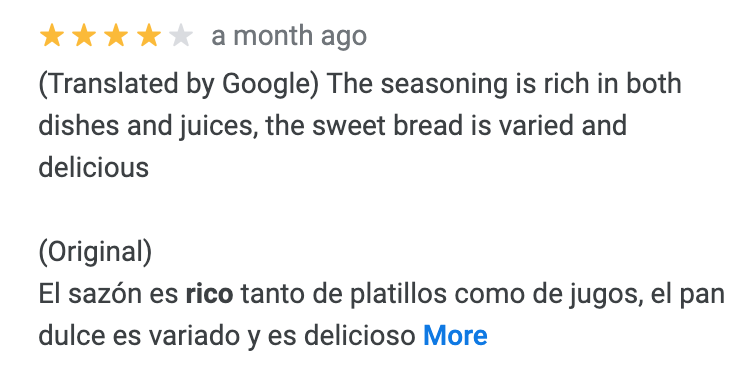
Uber is cheap and works very well in the cities where it’s available. Uber Eats delivers from restaurants and grocers.
See also
I often use the Lonely Planet guides as a starting point to plan a trip. I use it to narrow down potential areas to visit, and then I switch to researching online for detailed planning.
To learn about the history of civilization in Mexico and how it fits into the world, I highly recommend Charles Mann’s books “1491” and “1493”. Neither is exclusively about Mexico, but both feature it heavily, and you can use the index to skip to the Mexico-specific parts if you want.
Appendices
Road accidents data
Some data from Our World in Data for 2019:
Death rate from road injuries / 100k population
- France: 5.8
- USA: 11.1
- Mexico: 16.8
State department recommendations
If you want to trust the USA State Department instead of the official homicide data, they provide recommendations for each state in Mexico (But trusting a government agency’s recommendations is no way to live life. Remember when the CDC said not to visit Antarctica because of COVID danger?).
Here are the recommendations in map form:
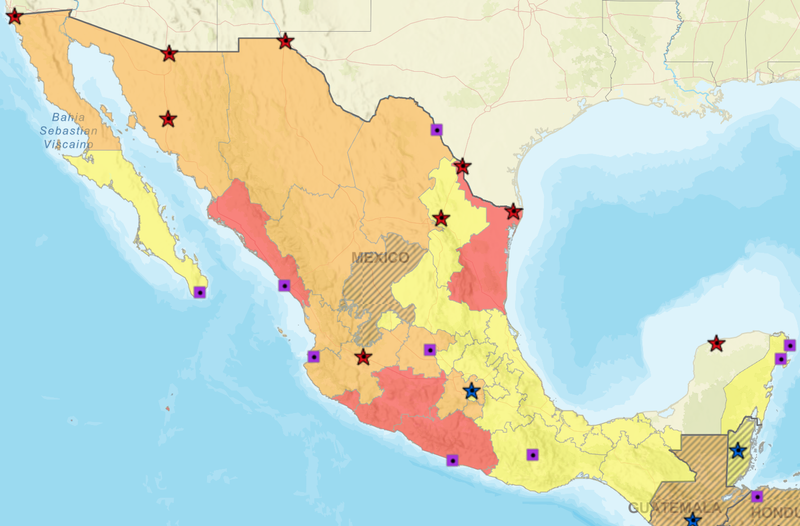
For comparison, Yucatan and Campeche (the light tan / unshaded ones on the bottom right) have the same rating as Switzerland, and yellow is the rating given to France and Germany.
We can see these correlate somewhat with the homicide data but not as well as I’d imagine. Probably some of this is the State Department being slow to update their recommendations, and some of it is that they take things other than homicide into account.
Crime data
All Homicide rates are per 100k population. Mexico data is 2022 data from El Crimen (Note: I spent a few minutes trying to get the official data for previous years from datos.gob.mx but I was unable to find it. If you can find it please let me know how). USA homicide numbers are from the FBI. Where the FBI provided counts rather than rates, I divided by population numbers from the 2020 US Census. For the USA I included both 2019 and 2020 because there was a spike in homicides in 2020 in the USA, so it’s hard to know which year is a more useful comparison. I threw in Paris for fun (I’m not sure if I interpreted the data correctly. I downloaded it from here and summed rows 5-8, columns RD-RS).


